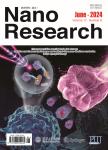Probing interactions at two-dimensional heterointerfaces by boron nitride-wrapped tip
由硼在二维的 heterointerfaces 探查相互作用包氮化物的尖端作者机构:Key Laboratory for Intelligent Nano Materials and Devices of the Ministry of EducationState Key Laboratory of Mechanics and Control of Mechanical StructuresNanjing University of Aeronautics and AstronauticsNanjing210016China
出 版 物:《Nano Research》 (纳米研究(英文版))
年 卷 期:2021年第14卷第3期
页 面:692-698页
核心收录:
学科分类:08[工学] 0805[工学-材料科学与工程(可授工学、理学学位)] 080502[工学-材料学]
基 金:This work was supported by National Key Research and Development Program of China(No.2019YFA0705400) National Natural Science Foundation of China(Nos.51535005 and 11702132) The authors also thank for supports from the China Postdoctoral Science Foundation(Nos.2016M600408 and 2017T100362) the Natural Science Foundation of Jiangsu Province(No.BK20170770) the Research Fund of State Key Laboratory of Mechanics and Control of Mechanical Structures(Nos.MCMS-I-0418K01 and MCMS-I-0419K01) the Fundamental Research Funds for the Central Universities(Nos.NZ2020001,NC2018001,NP2019301,and NJ2019002) A Project Funded by the Priority Academic Program Development of Jiangsu Higher Education Institutions
主 题:graphene molybdenum disulfide(MoS_(2)) boron nitride(BN) van der Waals force force-displacement curve
摘 要:Non-covalent interactions are important for two-dimensional heterointerfaces but challenged to be accurately determined,especially when the dielectric hexagonal boron nitride(BN)is ***,we present a comprehensive quantitative investigation on the interactions at the interfaces of BN-BN,BN-molybdenum disulfide,and BN-graphite using a BN-wrapped atomic force microscope tip and first-principle *** critical adhesion forces at BN-molybdenum disulfide and BN-graphite interfaces are measured to be 1.107±0.062 and 0.999±0.053 times that at BN-BN interface,respectively,while increase to 1.195±0.076 and 1.085±0.075 *** exposure of the tip to radiation in scanning electron microscopy,with data repeatability higher than 86%.The result with non-radiated tip agrees with the van der Waals interactions predicted by the state-of-the-art density functional theory-based vdW2D method,whereas the effect of radiation comes from the introduced charges in the tip,indicating the crucial roles of both dispersion and electrostatic interactions in construction,manipulation and device application of two-dimensional heterostructures.



